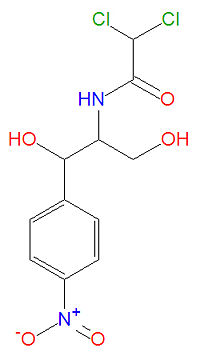Chloramphenicol: Difference between revisions
Jump to navigation
Jump to search

imported>David E. Volk (new stub) |
imported>David E. Volk mNo edit summary |
||
| Line 16: | Line 16: | ||
'''Chloramphenicol''' was the first broad-spectrum [[antibiotic]] discovered, in 1947, from ''[[Streptomyces venequelae]]'' cultures. Although it is active against a wide variety of organisms including [[tetracycline]]-resistant [[vibrio]]s, toxicity and safety concerns, such as bone marrow damage and anemia, typically limits its use to only the treatment of very serious infections, such as cholera and typhoid fever. The antibiotic works by binding to bacterial ribosome 50S subunits and inhibiting bacterial protein synthesis. | '''Chloramphenicol''' was the first broad-spectrum [[antibiotic]] discovered, in 1947, from ''[[Streptomyces venequelae]]'' cultures. Although it is active against a wide variety of organisms including [[tetracycline]]-resistant [[vibrio]]s, toxicity and safety concerns, such as bone marrow damage and anemia, typically limits its use to only the treatment of very serious infections, such as cholera and typhoid fever. The antibiotic works by binding to bacterial ribosome 50S subunits and inhibiting bacterial protein synthesis. | ||
Revision as of 15:34, 5 April 2009
|
| |||||||
| chloramphenicol | |||||||
| |||||||
| Uses: | antibiotic | ||||||
| Properties: | |||||||
| Hazards: | toxicity | ||||||
| |||||||
Chloramphenicol was the first broad-spectrum antibiotic discovered, in 1947, from Streptomyces venequelae cultures. Although it is active against a wide variety of organisms including tetracycline-resistant vibrios, toxicity and safety concerns, such as bone marrow damage and anemia, typically limits its use to only the treatment of very serious infections, such as cholera and typhoid fever. The antibiotic works by binding to bacterial ribosome 50S subunits and inhibiting bacterial protein synthesis.
